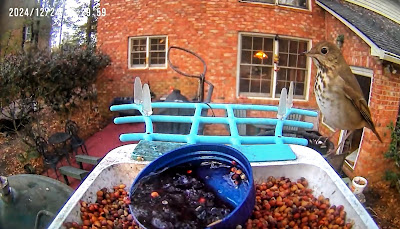This is an Orange-crowned Warbler. It resembles the Pine Warbler and a few other small birds that are regular or occasional visitors to our feeders. The screenshot above is from the 15-second video below. The clip at the beginning shows a Brown-headed Nuthatch and the aforementioned Pine Warbler.
Audubon calls the Orange-crowned Warbler "one of the plainest of warblers, the orange feathers on its head almost never visible, this species is also among the most hardy. In winter, when most warblers are deep in the tropics, Orange-crowns are common in the southern states."
The species' name comes from the orange patch on the male’s head. It is usually only seen when the male is in mating or alert mode. Leiothlypis Celaya is the bird’s scientific name. It means “hidden” or “secret." I have not seen nor photographed one where the orange strip is visible. I'm glad to see that this Warbler likes the grape jelly I have been putting out primarily for the Baltimore Orioles (see my post from January 2013). A few of these colorful birds have been feeding here for several weeks now.
Note the bands on this fellow’s legs. This allows scientists to track his patterns and other patterns.
This is a female Baltimore Oriole. Note the small spots on the head. Freckles perhaps?
The Hermit Thrush has been another recent visitor. I have seen this type over the years.
As I was about to publish this post I checked the new camera recordings and lo and behold an Orange-crowned Warbler just dropped in for a jelly refill.
Such a beautiful new addition to my lifer bird collection!
I'm very pleased with the feeder camera I acquired a few months ago. It's not Bird Buddy, which is quite popular. It is one I found on Amazon. Right now it is listed for just $75. I paid a bit more than that.
With the camera's app on my iPad, I can view the recordings and am notified when there are new ones. It looks like this. Note all of the lovely Baltimore Oriole visits I have had this morning!









No comments:
Post a Comment